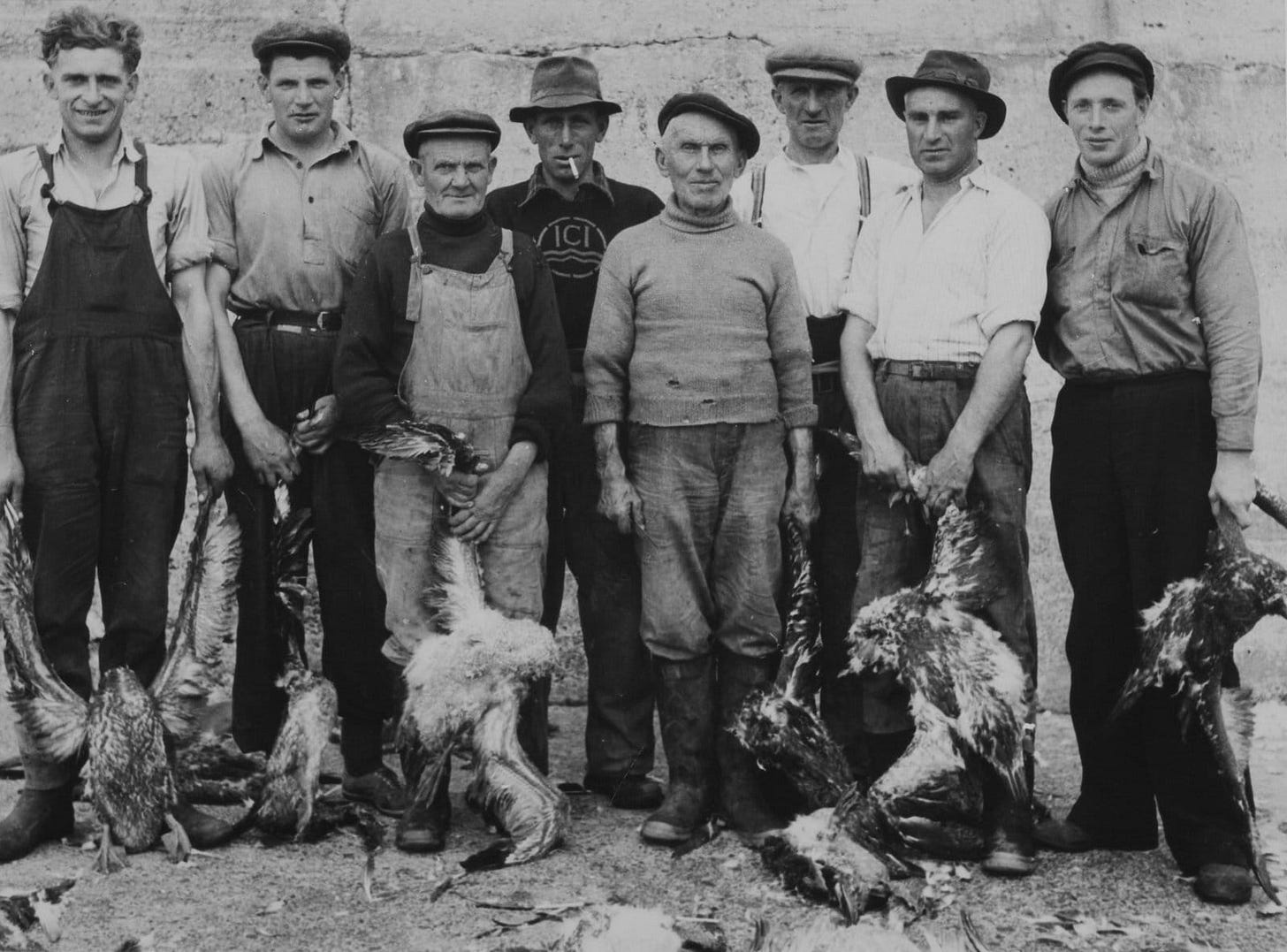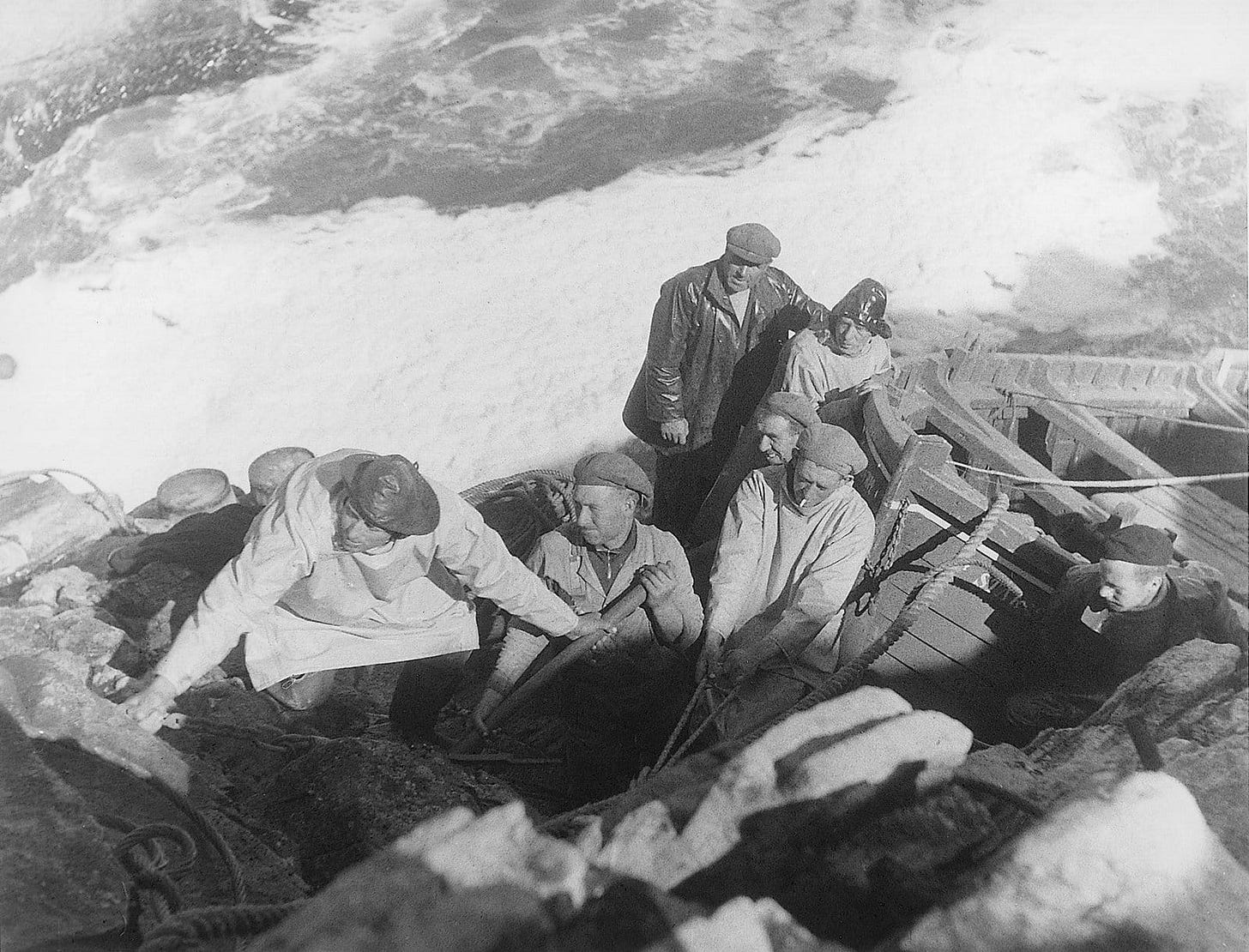"The Raids" - Sùlaisgeir after the Second World War.
With only one man left after the war who had been to Sùlaisgeir, how did the tradition continue?
One day, I was up in the loft and found interviews I had done twenty years ago with three men who went to Sùlaisgeir shortly after the Second World War. I thought the interviews were lost. I was so glad to find them.
I’ll write down what I remember – with An Gaisean and Murchadh Ruadh from Port, Eve from Skigersta, and Murchadh a’ Ghladstoin “Jellicoe” from Adabrock. If I get anything wrong, please tell me.
Thank you to Catriona McGeoch for letting her use photographs her father James McGeoch took at the time. The photographs are copyright the Estate of James MacGeoch.
Sùlaisgeir is about 70 nautical miles north of Ness. The people of Ness go there to take part in fowling (The Guga Hunt). In 1549, Donald Munro wrote that men from Ness would sail there in their open boats “"to fetche hame thair boatful of dry wild fowls with wild fowl fedderi".
After the war, I was told only one man had been there before – An Diùc. He passed on what he knew to others who started going out – in small boats (sgothan), villages racing each other out to the island to see who could come home with a catch first.
Fionnlagh MacLeod wrote in his book Sùlaisgeir that these years brought big changes to how the hunt was done. The changes have remained to this day.
This was no fixed tradition. They tried different ways and new equipment to see what worked best to serve their purpose. The started using blondins (a blondin cableway installation) and chutes, to make the work quicker. They even changed the equipment they used for fowling.
Back then, before fishing boats took people out, men from Ness rowed or sailed there in open boats called sgothan. By 1947, three boats were going, though not all were ready for the journey. These short trips were called “The Raids.” It was a race – who would get there first, who would bring the birds back first. An Gaisean told me, “We were kind of bored after the war.”
They went to kill the birds and bring them back as soon as possible. The women would pluck the birds at home, on the breakwater. They used the old style of open Ness boats, with sail and oars – the sgoth Niseach. Boats like An Catriona and Am Mayflower were in use at that time.
But things changed after the First World War and the sgothan were used less and less. The war in 1914 had affected the fishing. The new boats had engines (something for which the sgoth wasn’t well suited) and few new ones were built after 1914. They were hard to maintain and hard to use.
Murchadh Ruadh said that the iron nails were the main problem. After two years, you had to re-nail the boat. Any longer, and it was too far gone. When going to deep sea, the boat had to be in good shape.
One reason for the switch was safety. Open boats were dangerous. The Catriona was lost. So was the boat from Adabrock, the Mayflower.
I heard a story from many people – about Murchadh a’ Ghladstoin gold watch and the loss of the Mayflower. Murchadh a’ Ghladstoin (Jellicoe) told it to me, but he didn’t want to be recorded that day.
The Adabrock boat went out. A storm hit and they were stuck on the island for days. I doubt if they even had a sandwich between them. They hadn’t taken much water, either. They tried to save the Mayflower but the swell was too much and she was sunk.
Eachainn Chaluim Eachainn drank from a small pool and got sick, breaking out in boils. (When I asked Eachainn what it was like to go to Sùlaisgeir, he said, “It was hellish.”)
In the end, they saw the Stornoway lifeboat. The sea was still terribly rough. The captain said, “We’re going in, but I don’t think we’ll be coming out.” The lifeboat couldn’t get close enough so they threw a rope. Each man had to jump into the sea and be pulled aboard. That was the plan.
Eachainn was in such a rush he threw off his jacket. They found it a year later, where he had thrown it. Murchadh a’ Ghladstoin told him, as the lifeboat crew were about to pull him through the waves, “Careful, Eachainn, don’t get your feet wet.”
Then it was Murchadh a’ Ghladstoin’s turn. He remembered the gold watch from America he had brought as no one else on the crew had one. He didn’t want to lose it, so he stuck it under his chin and tied it fast. He grabbed the rope and jumped. They pulled him aboard so fast, the watch didn’t even get wet.
Three years earlier, there had been another bad storm. A passing tanker gave them a tow home. But the tanker was too fast. The boat creaked like it was breathing. But they got home. Calum a’ Bhodaich worked the pump. Murchadh a’ Ghladstoib steering. The pier at Skigersta was packed with people waiting. Calum a’ Bhodaich crouched by the engine and told his mate, ashamed they had been towed: “I’d rather have drowned!”
The races ended after that and they started to use fishing boats, staying as one crew on the island with the fishing boat taking them on and off. Maybe that was just as well. It was a dangerous thing and a miracle the crews of these boats survived.
As Murchadh Ruadh put it, when someone asked him who made up the crew of an open boat that they were both watching leave for Sùlaisgeir, he said, “Five fools and the Creator.”
END.
Would you like to read this piece in Gaelic?
You’ll find it here : ‘Na Raids’ - Sùlaisgeir after the Second World War.
Thank you for reading.




